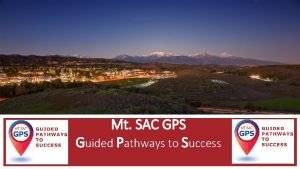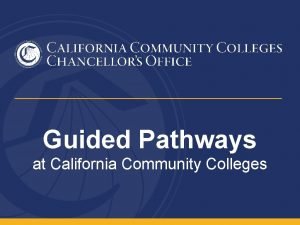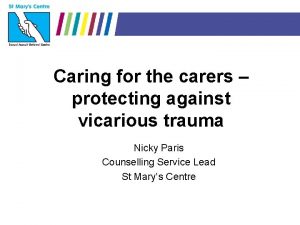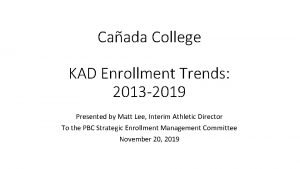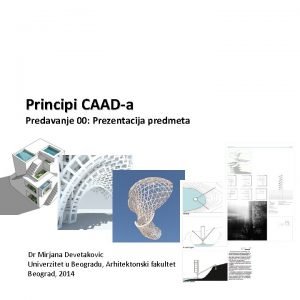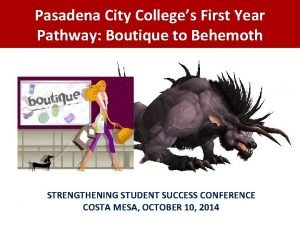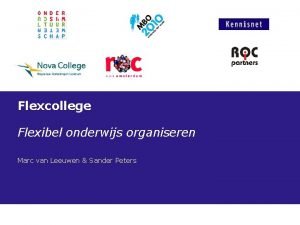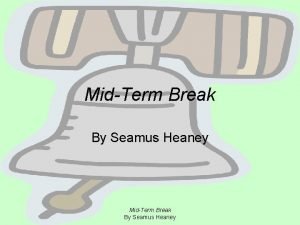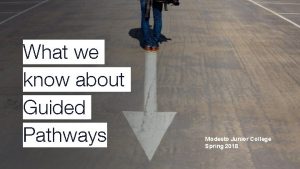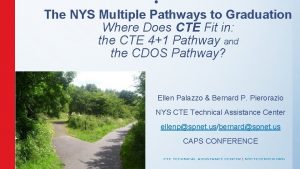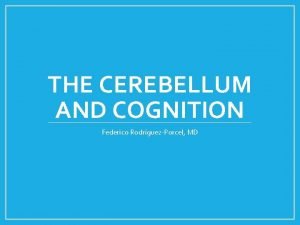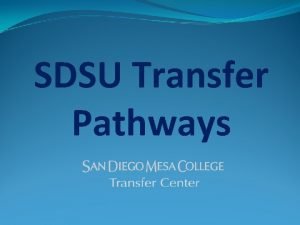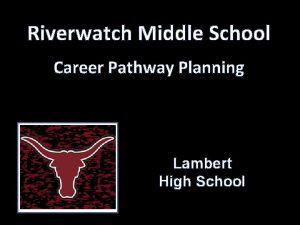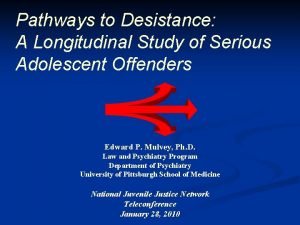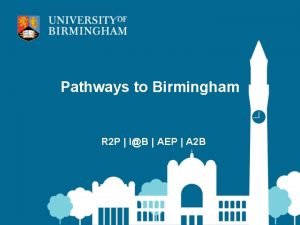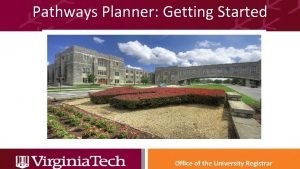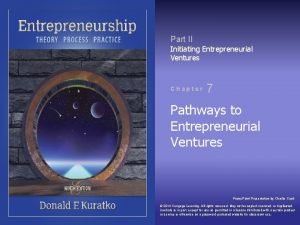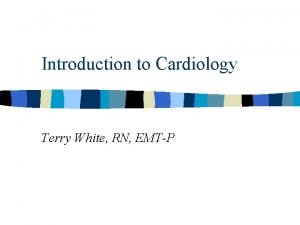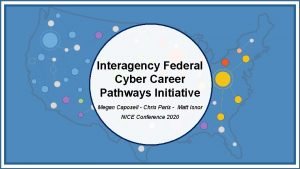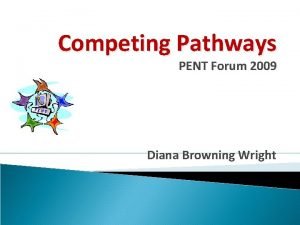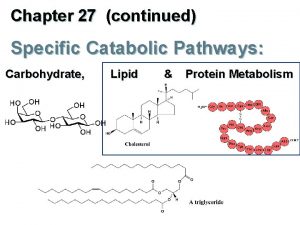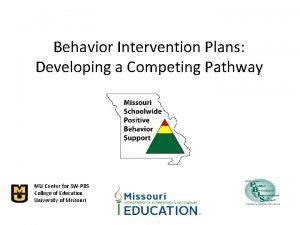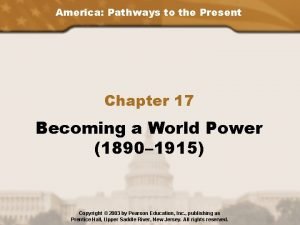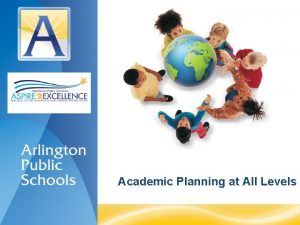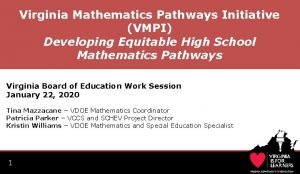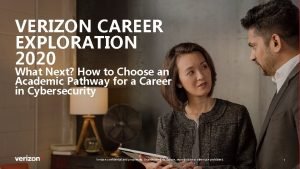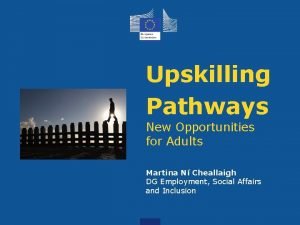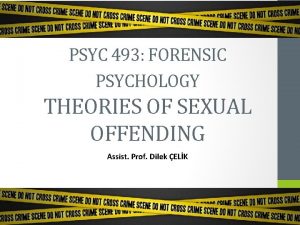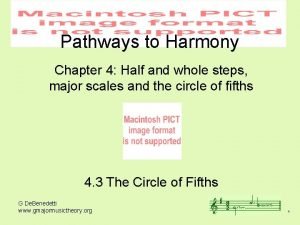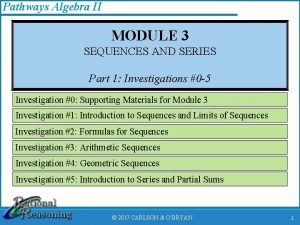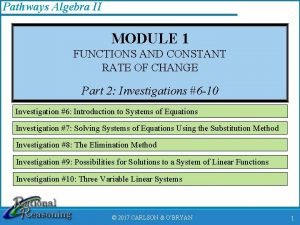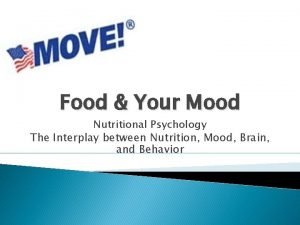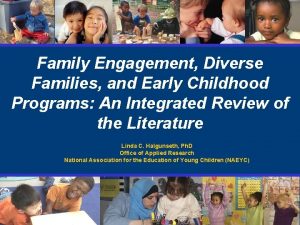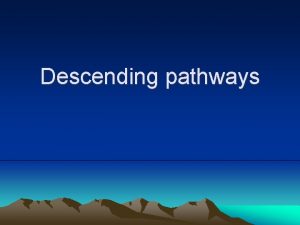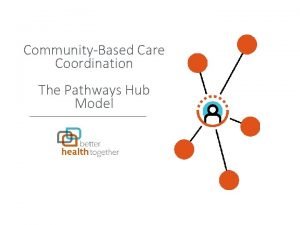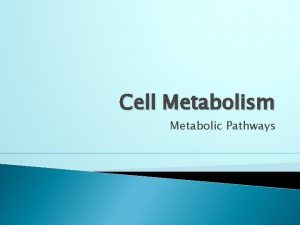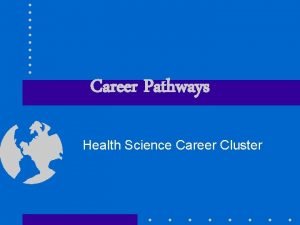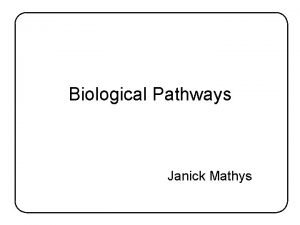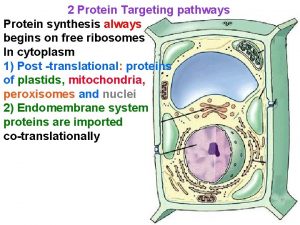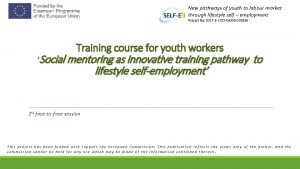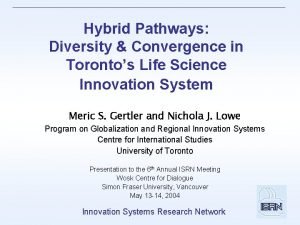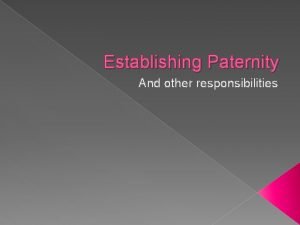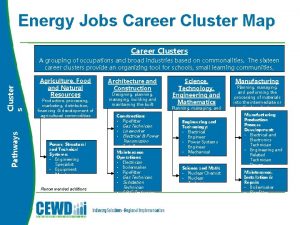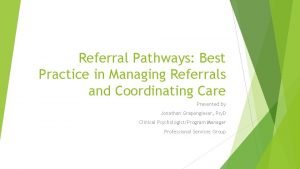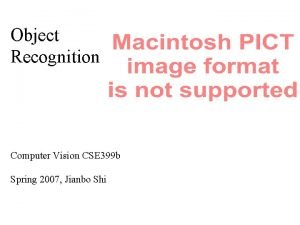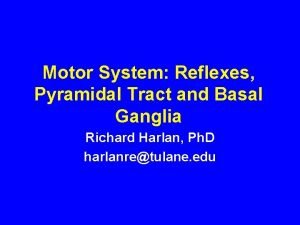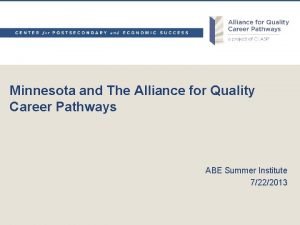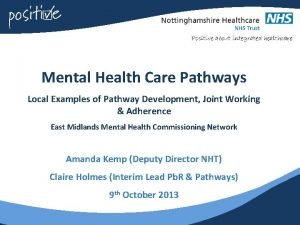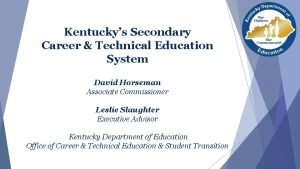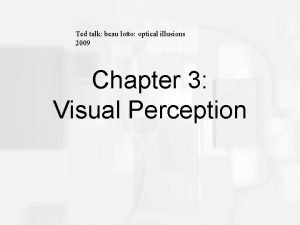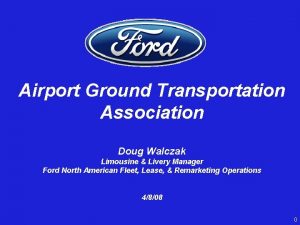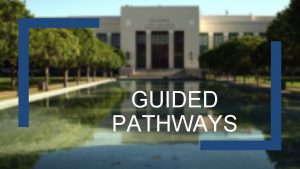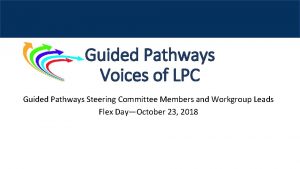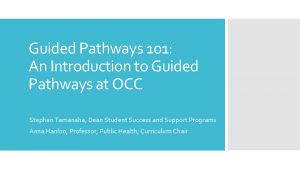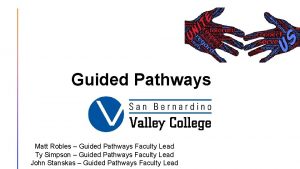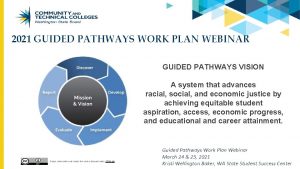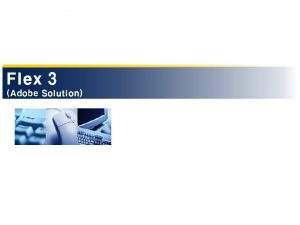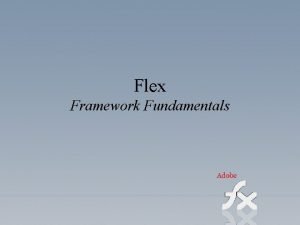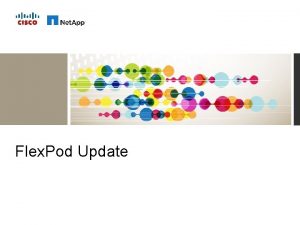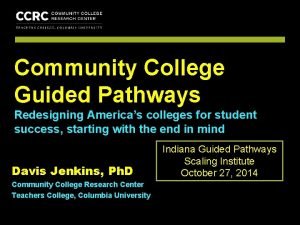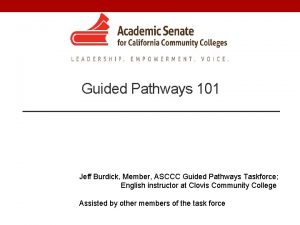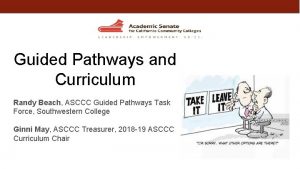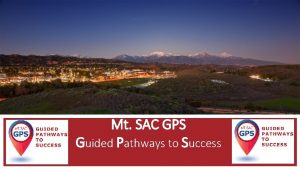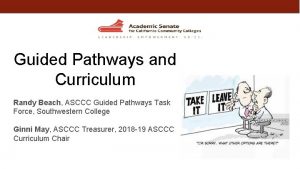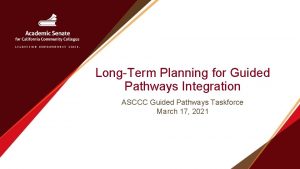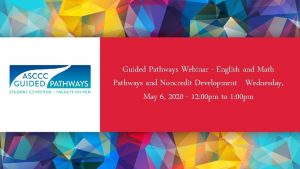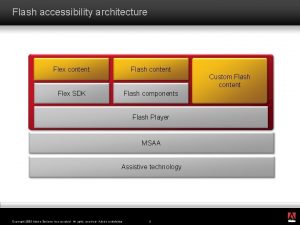Caada College Flex Day Morning Session Guided Pathways















































































































- Slides: 111

Cañada College Flex Day: Morning Session Guided Pathways 12 January 2018

Career Ladders Project fosters educational and career advancement through research , policy initiatives and direct assistance to community colleges and their partners.

Cañada College’s Pathway To Date • Spring Joint Division Meeting Workshop • IEPI Fall Guided Pathways Workshop • Cañada College Self Assessment • Guided Pathways Design Team Meeting • Spring 2018 Flex Day Workshop • Guided Pathway Design Team Meetings and Workshops

Our Path: This Morning • Why guided pathways? • What are guided pathways? • Are they working for students? & Later Today: • How are faculty and staff creating Guided Pathways? • What resources and discussion might be helpful to the Cañada community?

But first, burning questions! Please find a FAQ on your table, and please add to the large post-its on your tables what you wonder about guided pathways redesign? Design team to answer!

Why Guided Pathways?

62 %

Student Credit Accumulation: Excess Credits? Guided Pathway to Success: Boosting College Completion Complete College America http: //completecollege. org/docs/GPS_Summary_FINAL. pdf

Excess Credits: Impact on Student Learning & Resources • Student Learning • Degree and Transfer • Students are surprised to find that courses taken do not count towards credentials (Nodine et al 2012) • Completion • Students are not able to complete upon transfer because of loss of financial aid (Federal Aggregate Student Loan Limit=Associates +Bachelors) • Student Resources • Time • Longer time to complete increases cost of attendance (school and living expenses) • Money • Additional credits Cost Students additional $8 billion • Cost to government $11 B, potential federal student loan changes Matthew Zeidenberg, Valuable Learning or "Spinning Their Wheels"? Understanding Excess Credits Earned by Community College Associate Degree Completers http: //ccrc. tc. columbia. edu/publications/understanding -excess-credits. html

For the student who is not sure about program of study How clear are our offerings? College Student Profile: Jake First Generation College Student Interested in Computers Working Part Time

However, from the Major Selection:

Cañada College Certificates and Degrees

…to General Education Requirements clarity is needed.

Cañada College General Education

For the student who knows where she wants to focus, but places into the developmental sequence. How clear is the developmental sequence and programs? College Student Profile: Ellen Seeks an AA in business Working Part Time Responsible for care of elder parent placed into two levels below transfer math

Dev Ed Placement and Throughput Federal BPS (Beginning Postsecondary Students) data from 2009 indicate 68% of students beginning at public two-year colleges in 2003– 2004 took one or more remedial courses in the six years after their initial college enrollment. At four-year public colleges, it was 40 percent. Chen & Simone, 2016 Source: CCRC

Placement Rates by Race at 2 -year Colleges Chen & Simone, 2016

For Our Teams! And, ourselves!

Many college communities are facing initiative fatigue: Randy Tillery, Senior Dean, CCCCD

CA Community Colleges K 12 1000+ School Districts; 58 County Offices of Ed • • • Local Control Funding Formula (LCFF) Local Control and Accountability Plan (LCAP) Common Core State Standards Smarter Balanced Assessment Next Generation Science Standards CTE Standards and Framework CA Office to Reform Education (CORE) Waiver Districts CA Partnership Academies Linked Learning District Initiative AB 790 LL Pilot Districts Career Technical Education Incentive Grant CCC/K 12 • • SB 1070 CTE Pathways Program AB 86: Adult Ed/CCC Regional Consortia AB 86: CA Career Pathways Trust (CCPT) AB 288: College and Career Access Pathways (CCAP) Partnerships 72 Districts (112 Colleges, 76 Centers); 15 Regions 7 Workforce & Econ Dev Regional Consortia • • • • • Basic Skills Initiative Career Advancement Academies Enhanced Non-Credit SB 1440 Assoc. Degrees for Transfer Student Success Act of 2012 Online Education Initiative Common Assessment Initiative Multiple Measures Assessment Project Education Planning Initiative Doing What Matters ARCC; Scorecard and System Completion Goals Salary Surfer; Launchboard; CTE Data Unlocked CTE Enhancement Fund SB 850 CCC Bachelor’s Degree Pilots Student Equity Plans Basic Skills Student Outcomes and Transformation Program Institutional Effectiveness Partnership Initiative (IEPI) California College Promise Strong Workforce Program CCC Guided Pathways Program (proposed)

CA Workforce Development Board 48 Local Workforce Development Boards (47 areas) From WIA to WIOA • • • CA Strategic Workforce Dev Plan 2013 -17 Local Strategic Workforce Plans 2013– 17 CA Unified Strategic Workforce Development Plan 2016 -2020 (WIOA) Local Boards Strategic Workforce Dev Plan - TBD SB 118 Sector Strategies Prop 39 Clean Energy Job Creation Training Grants Workforce Accelerator Fund “Slingshot” Initiative (Regional Coalitions) Forward. Focus (AB 2060 Recidivism Reduction Funds) Other Regional Entities, Partnerships & Initiatives Examples include: • LA County Econ Development Corporation (LAEDC) • LA Chamber • LA Compact/UNITE-LA • United Way Los Angeles • Aspen Forum for Community Solutions Opportunity Youth Incentive Fund (7 CA sites, incl. LA) • James Irvine Foundation “Regional Hubs of Excellence” Federal Initiatives & Grant Programs • • • Perkins Career & Technical Education Act TAA Community College Training Grants Dislocated Worker Nat’l Emergency Grants Health and Human Services Grants SNAP Employment and Training Funds Apprenticeship USA State Expansion Funds Career Pathways for Youth Re-entry Demonstration Projects America’s Promise: American Tech Training Fund ETC. Other Related Agencies/Services in CA • • • Governor’s Office of Business & Econ Dev (GO-Biz) Cities, Counties Other Workforce Programs: Cal. Works; Rehabilitation; Corrections; Veterans Affairs, Apprenticeship; Health and Human Services; Social Services; Job Corps; Employment Training Panel; Public Utilities Commission; etc.

What if guided pathways could be a North Star for all of these initiatives?

Case Study: Bakersfield College Initiative Assessment for Integrated Planning College communities in California are finding Guided Pathways provides a framework for California’s improvement efforts. Clarity C-ID/ADT, CCPT, Strong Workforce Program, AEBG Intake Educational Planning Initiative Common Assessment Initiative Support Basic Skills Initiative, Basic Skills Transformation Learning Equity Initiative, Online Education Initiative Accreditation, Program Review, Planning, IEPI These college communities are focusing on students’ experiences rather than college structures or specific funding streams. Adapted from the work of Kathy Booth, CCCCO and Dr. Sonia Christian, President, Bakersfield College

Integrated Planning to Foster Student Success Academic Senate SSSP Strong Workforce Program Review Business Services College of the Canyons Institutional Effectiveness & Inclusive Excellence (IE)2 committeecoordinates student success data and supporting activities S 4 S ASG Institutional Effectiveness & Inclusive Excellence Title V Equity Performance Indicators PAC-B Curriculum Committee HR/ Prof. Dev. Non-credit CASL

What are Guided Pathways?

Guided Pathway: College Community Efforts to Nourish Success & Equity ● ● ● Improved Placement and Developmental Sequence Integrated and Proactive Student Supports Guided Exploration for Un/Decided Students ○ Clustering of Programs of Study into Meta Majors ○ Clearly Delineated Program Requirements (Default Sequences) ○ Early Career and College Exploration (K 12, adult school, career counseling, survey/contextualized courses, etc)

Integrated and Proactive Student Supports

Proactive and Integrated Student Supports • Academic Supports – Instructional – Counseling • Non-Academic Supports – Social – Economic When counseling resources are not part of classroom requirements or otherwise integrated into students’ educational experience, that the first generation and minority community college students who are most in need of accessing career counseling resources are least likely to approach them. (Karp et al 2011; Cox 2008).

Clustering of Degrees and Certificates into Meta Majors

Meta major • • Counseling Career Guidance Academic Support Connect to Non. Academic Support 1. Clustering of Degrees and Certificates into Meta Majors Program 14 Program 13 Program 12 Program 11 Program 10 Program 59 Program 48 Program 37 Program 62 Program 15 Program 4 Program 3 Program 2 Program 1 Key Foundational Courses

✓ Clear degree path ✓ Default course sequence Program 5 Program 4 Program 3 Program 2 Program 1 ✓ Predictable schedules 1. Clustering of Degrees and Certificates into Meta Majors


Mt SAC Career Clusters To begin this project, students across Mt. SAC divided our programs into 8 groups, called career clusters. Then the English Department developed ENGL 68 courses in the interest of those 8 career clusters. For example, if you're interested in art, but you need to complete your English courses first, you can choose the ENGL 68 under Arts & Design. This will allow students to be exposed to ideas related to art while completing an English course. The 8 career clusters are: ● Arts & Design ● Aviation, Electronics, & Manufacturing ● Business & Information Technology ● Health, Wellness, & Public Service ● Humanities & Communication ● Plants & Animals ● Sciences ● Teaching & Education

Sierra College DRAFT Interest Areas

CLEARLY DELINEATED PROGRAM REQUIREMENTS (DEFAULT SEQUENCE)

2. CLEARLY DELINEATED PROGRAM REQUIREMENTS (DEFAULT SEQUENCE)

Case Study: Mt. San Antonio Course Sequencing • Ordering of courses for each degree and certificate, including: ○ For each of their students (FT, PT, developmental sequence) ○ Mt. SAC Adult Ed Non Credit and HS pathways to sequencing work

Case Study: Sierra College • Mechanics • Champions created a template • Outline the recommended sequence of courses a student must complete in order to earn a degree, certificate or transfer with ADT • Provides recommended choices for General Education (GE) and electives • Mapping Days • Department faculty, counseling faculty, and team members completed over 150 award map templates

Case Study: DRAFT Sierra College Allied Health Interest Area Pathway Recommendation


But, are Guided Pathways working for students?

Guided Pathways Case Study: GSU Georgia State University Completion Rates GSU Implemented Guided Pathways • Meta-Majors • Default Sequences • Improved Developmental Education • Integrated Student Supports • Guided Exploration Source: http: //www. aacc. nche. edu/Resources/aaccprograms/pathways/Documents/Deploying. Guided. Pathways%20 at%20 Scals_Tim. Renic k_Ingrid. Thompson. Sellers. pdf

Guided Pathways Case Study: CUNY Guttman Community College Percentage of students graduating with an Associate’s Degree within 2 years

What can I expect at Cañada?

Case Study: Chaffey College Faculty Inquiry Team (FIT) Misty Burruel, Chaffey College https: //infograph. venngage. com/s/FRCr 8 Zp 0 m. JU

Case Study: Chaffey College Faculty Inquiry Team (FIT)

Questions? Concerns? Want to join the conversation? Team? Join your GP team next to learn more!

Questions? mkbergman@careerladdersproject. org cfischerhall@careerladdersproject. org

AM Deck ENDS HERE DRAFT PM DECK BEGINS

Cañada College Flex Day: Afternoon Session Guided Pathways 12 January 2018

Cañada College’s Path To Date • Spring Joint Division Meeting Workshop • IEPI Fall Guided Pathways Workshop • Cañada College Self Assessment • Guided Pathways Design Team Meeting • Spring 2018 Flex Day Workshop • Guided Pathway Design Team Meetings and Workshops

Our Path: This Morning • Why guided pathways? • What are guided pathways? • Are they working for students? & Now: • How are faculty and staff creating Guided Pathways? • What resources and discussion might be helpful to the Cañada community?

But first, burning questions! Please find a FAQ on your table, and please add to the large post-its on your tables what you wonder about guided pathways redesign? Design team to answer!

How are colleges engaging in Guided Pathways redesign?

Guided Pathways DESIGN PROCESS WHO? COMMON DESIGN STRUCTURES • Broad campus-wide participation, vetting, input, cross-functional teams • Cross-functional design team • Integrated planning - inclusive of college initiatives WHAT? COMMON DESIGN ELEMENTS • Inquiry • Meta-major creation (clustering of certs and degrees) • Reworked course sequencing • Backward mapping from competencies • Developmental education integration • Student support integration

Okay, how exactly have California faculty and staff made this journey?

Case Study: Chaffey College Faculty Inquiry Team (FIT) Misty Burruel, Chaffey College https: //infograph. venngage. com/s/FRCr 8 Zp 0 m. JU

College Community Efforts to Nourish Success & Equity via Guided Pathways ● Improved Placement and Developmental Sequence ● Guided Exploration for Un/Decided Students – – – Clustering of Programs of Study into Meta Majors Clearly Delineated Program Requirements (Default Sequences) Early College Credit ● Integrated Student Supports

Clustering of Degrees and Certificates into Meta Majors

CA Guided Pathway Redesign Case Studies: Mt. San Antonio Mt. SAC: • Faculty and staff teams reviewed existing degrees and certificates. • Then, sorted them into career clusters • After, Faculty and staff looked at the outcome and process, decided a voice was missing! • 60 groups of students (cross-section of the college’s students) completed the same exercise • Students had fun and questions! • Students helped clarify the clusters AND name them!

CA Guided Pathway Case Studies: Skyline College • 164 Degrees and Certificates • Fall 2016 Test Drive Process • Spring 2017 • Over two day period in January, 10 college-wide, crossfunctional teams sorted the degrees and certificates • The Most Common Clusters • Health Science & Wellness • Business, Entrepreneurship, & Professional Services • STEM (Science, Technology, Engineering, & Mathematics) • Social/Behavior Sciences & Public Service • Arts, Humanities, & Communication • Faculty and staff Design Team and Work Groups spent early spring refining, including naming and student voices

CA Guided Pathway Redesign Case Study: Sierra College Interest Areas Sierra College community worked to determine their Interest Areas: • Engaged in a number of sorting activities reaching out to everyone at the college (and to our feeder high schools)—over 175 participants • The, small group with representatives from all constituencies met to use input and data to

Sierra College DRAFT Interest Areas

Activity: Do these examples of meta majors support students with what they want to know: • What are my career options? • What are the education paths to those careers? • How do I get a bachelor’s degree? • What will I need to take? • How long will it take and how much will it cost? • How do I pay for it?

CLEARLY DELINEATED PROGRAM REQUIREMENTS (DEFAULT SEQUENCE)

Case Study: Mt. San Antonio Course Sequencing • Cross-functional faculty and staff teams • ordering of courses for each degreed and certificate, including: • For each of their students (FT, PT, developmental sequence) • Teams included Counseling, Student Support, and Instructional faculty (content area, English, math, ESL, reading, library, etc. )

Case Study: Mesa Community College Lessons Learned: • Cross Functional Mapping Sequence Teams • Start with the End in Mind MCC faculty and staff created “mapping sequence teams, ” cross-functional teams of instructional faculty and counseling faculty to clarify course sequence for each program. Work begins with competencies, teams work together to determine which GE, content courses meet the competencies for meta majors and what needs to be developed 2. CLEARLY DELINEATED PROGRAM REQUIREMENTS (DEFAULT SEQUENCE)

Case Study: Skyline College • CLP supported with models from colleges • Skyline VPs and Deans began the process • In Spring after MM drafting, developing process roles and responsibilities: • Design Team • I/SS Deans • Counseling, Student Support, and Instru • Meta Major Work Groups • Faculty and staff from across the campus funded to participate

Do these examples of sequencing support students with what they want to know: • What are my career options? • What are the education paths to those careers? • How do I get a bachelor’s degree? • What will I need to take? • How long will it take and how much will it cost? • How do I pay for it?

Integrated and Proactive Student Supports

Activity: Do these examples of meta majors support students with what they want to know: • What are my career options? • What are the education paths to those careers? • How do I get a bachelor’s degree? • What will I need to take? • How long will it take and how much will it cost? • How do I pay for it?

CLEARLY DELINEATED PROGRAM REQUIREMENTS (DEFAULT SEQUENCE)

Case Study: Mt. San Antonio Course Sequencing • Cross-functional faculty and staff teams • ordering of courses for each degreed and certificate, including: • For each of their students (FT, PT, developmental sequence) • Teams included Counseling, Student Support, and Instructional faculty (content area, English, math, ESL, reading, library, etc. )

Case Study: Mesa Community College Lessons Learned: • Cross Functional Mapping Sequence Teams • Start with the End in Mind MCC faculty and staff created “mapping sequence teams, ” cross-functional teams of instructional faculty and counseling faculty to clarify course sequence for each program. Work begins with competencies, teams work together to determine which GE, content courses meet the competencies for meta majors and what needs to be developed 2. CLEARLY DELINEATED PROGRAM REQUIREMENTS (DEFAULT SEQUENCE)

Case Study: Skyline College • CLP supported with models from colleges • Skyline VPs and Deans began the process • In Spring after MM drafting, developing process roles and responsibilities: • Design Team • I/SS Deans • Counseling, Student Support, and Instru • Meta Major Work Groups • Faculty and staff from across the campus funded to participate

Do these examples of sequencing support students with what they want to know: • What are my career options? • What are the education paths to those careers? • How do I get a bachelor’s degree? • What will I need to take? • How long will it take and how much will it cost? • How do I pay for it?

Integrated and Proactive Student Supports

Case Study: SMCCCD Student Voices in Pathways

CSM Case Study: Seven focus groups with 78 CSM students representing. . . • Sought to reflect diversity of campus, including but not limited to learning communities and adult schools graduates • Students attending evening and day classes • Students aged 15 - 61 (roughly 50% were 25 and under) • Race/Ethnicity: White (32. 4%), Hispanic (20. 6%), Multi Races (20. 6%), Asian (14. 7%), Pacific Islander and Filipino (7. 4%), Black (2. 9%), and Unknown (1. 5%) • 64 % women and 36% men

Focus group participants: Attempted and completed units: • 43% 0 -24 units attempted • 50% 0 -24 units completed (equivalent to 1 year or less fulltime coursework) Length of enrollment : ranged from 1 st semester students to those who first enrolled in 1986 • 50% enrolled after 2016 • 25% enrolled between 2013 and 2015

What we asked students: 1. How do you choose a major? 2. How do you choose courses each semester? 3. Which supports are helpful or would be helpful to you?

Synthesis of Findings: 1. Most students found choosing a major to be a daunting task. 2. Choosing courses and getting into the right class was challenging. 3. Students found available supports helpful, but many were unaware of the different types of supports that exist. 4. Some students yearn for a sense of community and peer connection. 5. Students valued counseling faculty and desired long-term relationships.


“I know a lot of people who have been here for 5 or 7 years, and they switched their major so many times, and that is why they are here for so long… and I think that happens so often because there isn’t really someone to sit down with them and say “Here , these are your strengths, these are careers that would be good for you, and these ones aren’t, ” … so that is why they keep jumping around. ” - California Community College Student

“This is the third time that I came back, and this time, I took the career assessment. I wish that I would have taken that the very first time because it would have set my path and maybe things wouldn't have been so out of reach. ”

“At least for me, it was about not knowing where to go. Like Communications, Okay, where do you go from there? Do I become a professor? Do I work in TV? What kind of jobs do It sounds corny, but are they happy in those job? ” people have? - California Community College Student

Most students found choosing a major to be a daunting task: • Difficulty in choosing a major was identified as a barrier to finishing on time. • Student attributed the difficulty in choosing a major to there being few opportunities to explore careers, and link how majors connect with those careers. • Most students felt taking courses was not a helpful strategy for career exploration.

Students’ Questions about Choosing a Major: 1. What are my career options? How do I get more information about those careers? 1. What are the different types of jobs that various majors lead to? 1. Is the major I am pursuing “practical” in terms of my ability to find a job with a decent salary later on?

Students’ suggestions for what resources would help them choose a major: • Learning about different careers including: • Guest speakers, daylong seminars, workshops, career fairs • Shadowing/ internship opportunities • Opportunities to be around students with similar areas of interest • A class that would provide overview of different majors and link them with careers. • Having all students take MBTI personality and Strong Interest Inventory assessment at the beginning of college.


Quotes from California Community College Students: “I found it really hard to find classes because I’m a big fan of not wasting time. So, I was like, I’m not going to take anything I don’t need to take. It was really hard. ”

Choosing courses and getting into the right class was often challenging, sometimes because a class was full, other times because the time the class was offered did not work with the students’ academic or work schedule.


Quotes from California Community College Student’s: “ …though my learning community I got to know about so many resources here on campus, like TRIO, Spark Point, EOPS. ”


Quotes from California Community College Student’s: “One thing that I think would help me, I think is to set up study groups… or even a classmate that is at your level to help you along– somebody you can communicate with and deal with to try to keep you motivated” “I feel like one of the biggest things that’s missing at college is a celebration of culture. Not just ethnic culture, but I mean even with in each major there’s a certain kind of unity… people just come in and out, and of course they’re not going to run into these services like TRIO or EOPS, because they’re not looking at bulletin boards or their email. ”

Counseling: • Students wished they could see the same counselors every time. • Students wished counselors had more specialized knowledge about a program. • Students wanted more time with counselors and for them to be available during the evenings. • Students appreciated SEP (student education plans) however found choosing a major difficult without • answering questions about careers • work experience

Small Group Discussion: Faculty & Staff Inquiry • Please join a table, try to sit with those you don’t get to work with often. • Please select a leader and a note taker for your table. • Work to answer all the questions. • Allow roughly 10 minutes for each question. • Chart paper is available to capture your table’s responses. • Responses will be synthesized to share back with the college community.

Table Team Activity: Are these student voices reflective of your students? • What else do your students say? • What else should we ask?

BRINGING STUDENT VOICES TO GUIDED PATHWAYS DESIGN

Who?

Cross-Functional Teams: Rich Experience & Perspective • • • Instructional, Counseling & Student Support Faculty and Staff Public Safety Facilities IT Finance IR • AND, most importantly…Students! •

Case Study: Skyline College, Campus-Wide Participation • CLP supported with models from colleges • Skyline VPs and Deans began the process • In Spring after MM drafting, developing process roles and responsibilities: • Design Team • I/SS Deans • Counseling, Student Support, and Instru • Meta Major Work Groups • Faculty and staff from across the campus funded to participate

Create an inclusive inquiry and work infrastructure

Case Study: Sierra College The task force is primarily comprised of instructional and special services faculty and educational administrators, selected for their roles and perspectives at the college; however, that body will employ full collaboration practices to ensure stakeholders are engaged, informed, and have every opportunity to provide input and feedback as the work unfolds. To support and inform its work, the task force will be evaluating effective practices around the state and the country and will bring best practices back to discuss with the college community at large. The task force has a two-year charter. Spring 2016 will primarily be spent researching and seeking input from the college; it expects to start making recommendations by 2016 -17 and implementing changes as they are approved with a full rollout in 2017 -18.

Case Integrated Study: Co. C Integrated Planning to Foster Student Success Academic Senate SSSP Strong Workforce Program Review Business Services • Institutional Effectiveness & Inclusive Excellence (IE)2 committee coordinates student success data and supporting activities S 4 S Institutional Effectivene ss & Inclusive Excellence Title V ASG Equity Performance Indicators PAC-B Curriculum Committee HR/ Prof. Dev. Non-credit CASL

Case Study: Chaffey College Faculty Inquiry Team (FIT) Misty Burruel, Chaffey College https: //infograph. venngage. com/s/FRCr 8 Zp 0 m. JU

Case Study: Chaffey College Faculty Inquiry Team (FIT)

Cañada College Who! • Meet your GP Team

Activity: Cañada College Who? • Your GP Team – Who is missing? – Take a cross-functional team inventory – You? • How to join! • How would you like the team to communicate with you?

Questions? mkbergman@careerladdersproject. org cfischerhall@careerladdersproject. org
 Day 1 day 2 day 3 day 4
Day 1 day 2 day 3 day 4 Mt sac guided pathways
Mt sac guided pathways Guided pathways california community colleges
Guided pathways california community colleges West los angeles college
West los angeles college Caada tree care
Caada tree care Caada moodle
Caada moodle Moodle arh bg
Moodle arh bg Day 1 day 2 day 817
Day 1 day 2 day 817 Pasadena city college pathways
Pasadena city college pathways Flexibel onderwijs organiseren
Flexibel onderwijs organiseren Morning i see you in the sunrise
Morning i see you in the sunrise Good morning professor english
Good morning professor english Ding ding ding good morning
Ding ding ding good morning Good evening teacher
Good evening teacher Good morning and welcome everyone
Good morning and welcome everyone Good morning i am fine
Good morning i am fine Formal greetings and responses
Formal greetings and responses Hello teacher good afternoon
Hello teacher good afternoon I got up early one morning and rushed into the day
I got up early one morning and rushed into the day Starter of the day activity soda morning soft start
Starter of the day activity soda morning soft start Starter of the day activity soda morning soft start
Starter of the day activity soda morning soft start Mid term poem
Mid term poem Poppy bruise meaning
Poppy bruise meaning Pgcps calendar a day b day
Pgcps calendar a day b day Oceans apart day after day
Oceans apart day after day Day to day maintenance
Day to day maintenance As your room gets messier day by day, entropy is
As your room gets messier day by day, entropy is I don't know about tomorrow
I don't know about tomorrow Romeo and juliet timeline activity
Romeo and juliet timeline activity Growing day by day
Growing day by day Define seed dormancy
Define seed dormancy Seed germination conclusion
Seed germination conclusion Seeds vs spores
Seeds vs spores I live for jesus day after day
I live for jesus day after day Casting crowns glorious day (living he loved me)
Casting crowns glorious day (living he loved me) Day one day one noodle ss2
Day one day one noodle ss2 Afc futsal coaching course level 1
Afc futsal coaching course level 1 College signing day certificate template
College signing day certificate template Asd college college readiness program
Asd college college readiness program Early college high school at midland college
Early college high school at midland college Pathways modesto
Pathways modesto Nys graduation pathways
Nys graduation pathways Dysmetria
Dysmetria South forsyth high school pathways
South forsyth high school pathways Sdsu pathways
Sdsu pathways Lambert high school pathways
Lambert high school pathways Pathways to desistance
Pathways to desistance Pathways to birmingham partner school
Pathways to birmingham partner school Pathways planner
Pathways planner The pathways to new ventures for entrepreneurs
The pathways to new ventures for entrepreneurs Depolarization and repolarization
Depolarization and repolarization Megan caposell
Megan caposell Higher biology metabolic pathways
Higher biology metabolic pathways German school system
German school system Base excision repair
Base excision repair Corticospinal tract pathway
Corticospinal tract pathway Label the components of the conduction system.
Label the components of the conduction system. Competing pathways chart
Competing pathways chart Entrepreneurial pathways meaning
Entrepreneurial pathways meaning Catabolic pathways
Catabolic pathways Organic chemistry reaction pathways
Organic chemistry reaction pathways Internodal pathways
Internodal pathways Problem behavior pathway example
Problem behavior pathway example Sa node on ecg
Sa node on ecg Prentice hall america pathways to the present
Prentice hall america pathways to the present Apsva math pathways
Apsva math pathways Sas curriculum pathways
Sas curriculum pathways Virginia math pathways initiative
Virginia math pathways initiative Verizon career pathways
Verizon career pathways Upskilling pathways
Upskilling pathways Ward and siegert's pathways model
Ward and siegert's pathways model Pathways to harmony chapter 1 answers
Pathways to harmony chapter 1 answers Pathways pediatric therapy
Pathways pediatric therapy Algebra 2 module 3
Algebra 2 module 3 Algebra 2 module 1 answer key
Algebra 2 module 1 answer key Dopamine and serotonin pathways
Dopamine and serotonin pathways Naeyc pathways to cultural competence checklist
Naeyc pathways to cultural competence checklist Energy-releasing pathways
Energy-releasing pathways Weathering
Weathering Lateral white column
Lateral white column Descending pathways
Descending pathways Metabolic pathways higher human biology
Metabolic pathways higher human biology Pathways hub model
Pathways hub model Alternative metabolic pathways
Alternative metabolic pathways 5 healthcare career pathways
5 healthcare career pathways Metabolic pathways
Metabolic pathways Protein targeting pathways
Protein targeting pathways Uc transfer pathways
Uc transfer pathways Ruth binks inverclyde council
Ruth binks inverclyde council Pathways to harmony chapter 1 answers
Pathways to harmony chapter 1 answers New pathways for youth jobs
New pathways for youth jobs Hybrid pathways
Hybrid pathways Higher human biology metabolic pathways
Higher human biology metabolic pathways Higher biology metabolic pathways
Higher biology metabolic pathways Therapeutic services pathway
Therapeutic services pathway What are the 3 pathways to paternity?
What are the 3 pathways to paternity? Chapter 7 a closer look energy metabolism pathways
Chapter 7 a closer look energy metabolism pathways Energy career cluster pathways
Energy career cluster pathways Brain parenchyma
Brain parenchyma Delirium care pathways
Delirium care pathways Chapter 7 a closer look energy metabolism pathways
Chapter 7 a closer look energy metabolism pathways Somatic motor pathways
Somatic motor pathways Referral pathways
Referral pathways Visual pathways
Visual pathways Direct and indirect motor pathways
Direct and indirect motor pathways Quality career pathways
Quality career pathways Care pathway example
Care pathway example David horseman
David horseman Exploitation plan example
Exploitation plan example Visual pathways
Visual pathways Pathways livery
Pathways livery Victorian curriculum writing samples
Victorian curriculum writing samples

